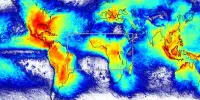Between 1990 and 2019, heatwaves caused more than 150,000 deaths worldwide each year, according to a new study published in PLOS Medicine by Yuming Guo of Monash University in Australia and colleagues.
Heatwaves, or periods of exceptionally high ambient temperature that last a few days, can cause severe thermal stress on the human body. Previous studies have assessed the influence of specific heatwaves on excess deaths in particular locations, but these figures have not been compared globally over such a long period of time.
In the latest study, researchers analyzed data from the Multi-Country Multi-City (MCC) Collaborative Research Network, which includes daily fatalities and temperatures from 750 locations in 43 nations. Using MCC data, the researchers predicted excess heatwave deaths around the world from 1990 to 2019 and mapped the variation in these deaths by continent.
Heatwaves are associated with substantial mortality burden that varies spatiotemporally over the globe in the past 30 years. These findings indicate the potential benefit of government actions to enhance health sector adaptation and resilience, accounting for inequalities across communities.
Yuming Guo
From 1990 to 2019, heatwave-related excess deaths accounted for 153,078 deaths per year, a total of 236 deaths per 10 million residents, or 1% of all deaths worldwide. While Asia had the most estimated deaths, Europe had the greatest population-adjusted rate, with 655 deaths per ten million people.
A substantial burden of estimated deaths was seen in southern and eastern Europe as well as the area between Northern Africa, the Arabian Peninsula and Southern Asia. At the national level, Greece, Malta, and Italy had the highest excess death ratios. Overall, the largest estimated rates of heatwaves deaths were seen in areas with dry climates and lower-middle incomes. Understanding the regional disparity of heatwave-related mortality is key to planning local adaptation and risk management towards climate change.

“Heatwaves are associated with substantial mortality burden that varies spatiotemporally over the globe in the past 30 years,” the authors say. “These findings indicate the potential benefit of government actions to enhance health sector adaptation and resilience, accounting for inequalities across communities.”
The authors continue, “In the context of climate change, it is critical to address the disproportionate impacts of heatwaves on human health. This needs a multifaceted approach that addresses not only urgent health hazards during heatwaves, but also long-term efforts for reducing vulnerability and inequality. Climate change mitigation policies, heat response plans (for example, a heat early warning system), urban planning and green structure, social assistance programs, healthcare and public health services, education awareness, and community engagement and participation are among the strategies.
















